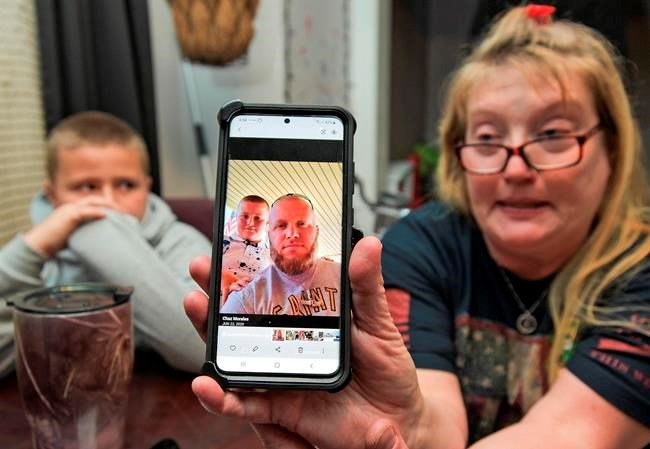PORT FOURCHON, La. — Coast Guard boats and aircraft have covered an area larger than the state of Rhode Island to search for 12 people still missing Wednesday off the Louisiana coast after their offshore oilfield vessel capsized in hurricane-force winds.
One worker's body was recovered Wednesday and six people were rescued Tuesday after the Seacor Power overturned Tuesday afternoon in the Gulf of Mexico, the Coast Guard said.
The search, interrupted by darkness and bad weather, has
Coast Guard Capt. Will Watson said earlier that winds were 80 to 90 mph (130 to 145 kph) and waves rose 7 to 9 feet high (2.1 to 2.7
“That’s challenging under any circumstance,” Watson said. “We don’t know the degree to which that contributed to what happened, but we do know those are challenging conditions to be out in the maritime environment.”
The bulky vessel, also called a jackup rig because it has three long legs it can lower to the sea floor to lift the boat out of the water as an offshore platform, flipped over Tuesday afternoon south of Port Fourchon, a major base for the U.S. oil and gas industry.
One worker was found dead on the surface of the water, Watson said at a news conference Wednesday. Asked about the missing workers' prospects, he said, “We are hopeful. We can’t do this work if you’re not optimistic, if you’re not hopeful.”
Divers were heading to the local area Wednesday afternoon, Coast Guard spokesman Petty Officer John Micheli said.
Numerous other agencies helped with the search.
Marion Cuyler, the fiancée of crane operator Chaz Morales, was waiting with family of other missing workers at a Port Fourchon fire station near a landing site where helicopters were coming and going. She said she talked to her fiancé before he left Tuesday.
“He said that they were jacking down and they were about to head out, and I’m like, ‘The weather’s too bad. You need to come home.’ And he’s like, ‘I wish I could.’”
The relationship of those on board to owner Seacor Marine was not immediately clear. The boat, capable of working in up to 195 feet (nearly 60
“We are deeply saddened by the news of the vessel capsizing and are working closely with the U.S. Coast Guard and local authorities to support all efforts to locate our valued team members and partners,” the Houston-based company said in a statement.
Watson said the Coast Guard is investigating what part the harsh weather played in the accident. The vessel left Port Fourchon at 1:30 p.m. Tuesday, bound for Main Pass off the southeast Louisiana coast, he said.
“We did have some weather reports yesterday that there would be some challenging weather. But this level of weather was not necessarily anticipated,” he said.
The National Weather Service in New Orleans issued a special marine warning before 4 p.m. Tuesday that predicted steep waves and winds greater than 50 knots (58 mph).
The Coast Guard received a distress message from a good Samaritan at 4:30 p.m. and issued an urgent marine broadcast that prompted multiple private vessels in the area to respond, saving four people, the agency said. Coast Guard crews rescued another two people.
At one point, video showed the boat — 129 feet (39
Although the Coast Guard said the lift boat capsized during a microburst, a National Weather Service meteorologist said the system was more like an offshore derecho — or straight winds storm.
“This was not a microburst -- just a broad straight-line wind event that swept over a huge area,” Phil Grigsby said.
He said the weather service's nearest official gauge, at Grand Isle, showed about 30 minutes of 75 mph (120 km/h) winds, followed by hours of winds over 50 mph (80 km/h).
The initial storm system was followed by a low-pressure system called a wake low, which amplified the winds and made them last longer, Grigsby said.
“It was the strongest wake low I've seen in almost 18 years here,” he said.
Shrimp boat captain Aaron Callais said the bad weather started with small, quickly dissipating waterspouts that buffeted his father's boat, the Ramblin’ Cajun.
“There was nothing we could do. One minute we were facing north, the next south, then east and west,” he said. "Things were flying in the cabin.'
Callais posted video on Facebook of wind battering the boat as he talked on the boat's satellite phone to friends and family, including his dad, “letting him know the situation, that it wasn’t looking good. We didn’t know if we were going to make it out.”
___
The length of the capsized vessel has been corrected; it has a beam of 129 feet, not 265 feet.
___
Associated Press writer Janet McConnaughey contributed to this report from New Orleans. McGill reported from New Orleans and Martin reported from Marietta, Georgia.
Stacey Plaisance, Kevin McGill And Jeff Martin, The Associated Press




